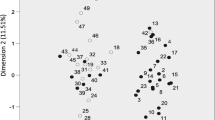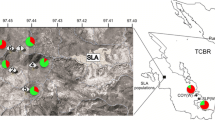Abstract
Genetic variability in 10 natural Tunisian populations of Medicago laciniata were analysed using 19 quantitative traits and 12 polymorphic microsatellite loci. A large degree of genetic variability within-populations and among-populations was detected for both quantitative characters and molecular markers. High genetic differentiation among populations for quantitative traits was seen, with Q ST = 0.47, and F ST = 0.47 for microsatellite markers. Several quantitative traits displayed no statistical difference in the levels of Q ST and F ST . Further, significant correlations between quantitative traits and eco-geographical factors suggest that divergence in the traits among populations may track environmental differences. There was no significant correlation between genetic variability at quantitative traits and microsatellite markers within populations. The site-of-origin of eco-geographical factors explain between 18.13% and 23.40% of genetic variance among populations at quantitative traits and microsatellite markers, respectively. The environmental factors that most influence variation in measured traits among populations are assimilated phosphorus (P205) and mean annual rainfall, followed by climate and soil texture, altitude and organic matter. Significant associations between eco-geographical factors and gene diversity, H e , were established in five-microsatellite loci suggesting that these simple sequence repeats (SSRs) are not necessarily biologically neutral.
Similar content being viewed by others
References
Badri M., Lazrek F., Huguet T. and Aouani M. E. 2002 Variabilité morphologique et moléculaire des populations naturelles de la légumineuse modéle Medicago truncatula Gaertn. (Fabacées). Proceedings of the 1st Franco-Maghrebean Symposium on the Biotechnological Applications of the Nitrogen Fixation (ed. M. E. Aouani), pp. 10–15. Hammamet, Tunisia.
Badri M., Ilahi H., Huguet T. and Aouani M. E. 2007 Quantitative and molecular genetic variation in sympatric populations of Medicago laciniata and M. truncatula (Fabaceae): relationships with eco-geographical factors. Genet. Res. 89, 107–122.
Belkhir K. 2001 Genetix software, version 4.01. Laboratoire Genome, Populations, Interactions, CNRS UPR 9060, Montpellier.
Bena G., Prosperi J. M., Lejeune B. and Olivieri I. 1998 Evolution of annual species of the genus Medicago: a molecular phylogenetic approach. J. Mol. Evol. 9, 552–559.
Bonnin I., Prosperi J. M. and Olivieri I. 1996 Genetic markers and quantitative genetic variation in Medicago truncatula (Leguminoseae): a comparative analysis of population structure. Genetics 143, 1795–1805.
Bonnin I., Prosperi J. M. and Olivieri I. 1997 Comparison of quantitative genetic parameters between two natural populations of a selfing plant species, Medicago truncatula Gaertn. Theor. Appl. Genet. 94, 641–651.
Chan Y. and Arcese P. 2003 Morphological and microsatellite differentiation in Melospiza melodia (Aves) at a microgeographic scale. J. Evol. Biol. 16, 939–947.
Charlesworth D. 2003 Effects of inbreeding on the genetic diversity of populations. Phil. Trans. R. Soc. Lond. B 358, 1051–1570.
Cook D. 1999 Medicago truncatula: a model in the making! Curr. Opin. Plant Biol. 2, 301–304.
Crnokrak P. and Roff D. A. 1995 Dominance variance — associations with selection and fitness. Heredity 75, 530–540.
Cruse-Sanders J. M. and Hamrick J. L. 2004 Spatial and genetic structure within populations of wild American ginseng (Panax quinquefolius L., Araliaceae). J. Hered. 95, 309–321.
Diwan N., Bauchan G. R. and Mclntosh M. S. 1994 A core collection for the United States annual Medicago germplasm collection. Crop Sci. 34, 279–285.
El-Kassaby Y. and Ritland K. 1996 Genetic variation in low elevation Douglas-fir of British Columbia and its relevance to gene conservation. Biodivers. Conserv. 5, 779–794.
Ellwood S. R., D’souza N. K., Kamphuis L. G., Burgess T. I., Nair R. M. and Oliver R. P. 2006 SSR analysis of the Medicago truncatula SARDI core collection reveals substantial diversity and unusual genotype dispersal throughout the Mediterranean basin. Theor. Appl. Genet. 112, 977–983.
Eujayl I., Sledge M. K., Wang L., May G. D., Chekhovskiy K., Zwonitzer J. C. and Mian M. A. R. 2004 Medicago truncatula EST-SSRs reveal cross-species genetic markers forMedicago spp. Theor. Appl. Genet. 108, 414–422.
Falconer D. S. and Mackay T. F. C. 1996 Introduction to quantitative genetics, 4th edition. Longman, London.
Garau G., Reeve W. G., Brau L., Deiana P., Yates R. J., James D. et al. 2005 The symbiotic requirements of different Medicago spp. suggest the evolution of Sinorhizobium meliloti and S. medicae with hosts differentially adapted to soil pH. Plant Soil 176, 263–277.
Gherardi M., Mangin B., Bonnet D., Goffinet B. and Huguet T. 1998 A method to measure genetic distance between allogamous populations of alfalfa (Medicago sativa) using RAPD molecular markers. Theor. Appl. Genet. 96, 406–412.
Goudet J. 1995 FSTAT, a computer program to calculate F-statistics (version 1.2). J. Hered. 86, 485–486.
Gutierrez M. V., Vaz Patto M. C., Huguet T., Cubero J. I., Moreno M. T. and Torres A.M. 2005 Cross-species amplification of Medicago truncatula microsatellites across three major pulse crops. Theor. Appl. Genet. 110, 1210–1217.
Heyn C. C. 1963 The annual species of Medicago. Scr. Hierosolymitana 12, 1–154.
Hogbin P. M. and Peakall R. 1999 Evaluation of the contribution of genetic research to the management of the endangered plant Zieria prostrata. Conserv. Biol. 13, 514–522.
Huang Q. Y., Beharav A., Youchun U. C., Kirzhner V. and Nevo E. 2002 Mosaic microecological differential stress causes adaptive microsatellite divergence in wild barley, Hordeum spontaneum, at Neve Yaar, Israel. Genome 45, 1216–1229.
Hughes W. O. H. and Boomsma J. J. 2004 Genetic diversity and disease resistance in leaf-cutting ant societies. Evolution 58, 1251–1260.
Innan H., Terauchi R. and Miyashita N. T. 1997 Microsatellite polymorphism in natural populations of wild plant Arabidopsis thaliana. Genetics 146, 1441–1452.
Isabel N., Beaulieu J., Thériault P. and Bousquet J. 1999 Direct evidence for biased gene diversity estimates from dominant random amplified polymorphic DNA (RAPD) fingerprints. Mol. Ecol. 8, 477–483.
Ivandic V., Hackett C. A., Nevo E., Keith R., Thomas W. T. B. and Forster B. P. 2002 Analysis of simple sequence repeats (SSRs) in wild barley from the Fertile Crescent: associations with ecology, geography and flowering time. Plant Mol. Biol. 48, 511–527.
Jaramillo-Correa J. P., Beaulieu J. and Bousquet J. 2001 Contrasting evolutionary forces driving population structure at expressed sequence tag polymorphisms, allozymes and quantitative traits in white spruce. Mol. Ecol. 10, 2729–2740.
Juan A., Crespo M. B., Cowan R. S., Lexer C. and Fay M. F. 2004 Patterns of variability and gene flow in Medicago citrina, an endangered endemic of islands in the western Mediterranean, as revealed by amplified fragment length polymorphism (AFLP). Mol. Ecol. 13, 2679–2690.
Kremer A., Zanetto A. and Ducousso A. 1997 Multilocus and multitrait measures of differentiation for gene markers and phenotypic traits. Genetics 145, 1229–1241.
Latta R. G. 1998 Differentiation of allelic frequencies at quantitative trait loci affecting locally adaptive traits. Am. Nat. 151, 293–292.
Latta R. G. and Mitton J. B. 1997 A comparison of population structure across four classes of gene marker in limber pine. Genetics 146, 1153–1163.
Lesins K. A. and Lesins I. 1979 Genus Medicago (Leguminoseae): a taxogenetic study, pp. 1–228. Junk Publishers, Netherlands.
Li Y., Röder M. S., Fahima T., Beiles A., Korol A. and Nevo E. 2000 Natural selection causing microsatellite divergence in wild emmer wheat at the ecologically variable microsite at Ammiad, Israel. Theor. Appl. Genet. 100, 985–999.
Li Y. C., Krugman T., Fahima T., Beiles A., Korol A. B. and Nevo E. 2001 Spatiotemporal allozyme divergence caused by aridity stress in a natural population of wild wheat, Triticum dicoccoides, at the Ammiad microsite, Israel. Theor. Appl. Genet. 102, 853–864.
Lopez-Fanjul C., Fernandez A. and Toro M. A. 2003 The effect of neutral nonadditive gene action on the quantitative index of population divergence. Genetics 164, 1627–1633.
Mantel N. 1967 The detection of disease clustering and a generalized regression approach. Cancer Res. 27, 1055–1067.
Merilä J. and Crnokrak P. 2001 Comparison of differentiation at marker loci and quantitative traits. J. Evol. Biol. 14, 892–903.
Mitton J. B. and Duran K. L. 2004 Genetic variation in pinon pine, Pinus edulis, associated with summer precipitation. Mol. Ecol. 13, 1259–1264.
Morgan T. J., Evans M. A., Garland Jr T., Swallow J. G. and Carter P. A. 2005 Molecular and quantitative genetic divergence among populations of house mice with known evolutionary histories. Heredity 94, 518–525.
Nei M. 1978 Estimation of average heterozygosity and genetic distance from a small number of individuals. Genetics 89, 583–590.
Palo J. U., O’Hara R. B., Laugen A. T., Laurila A., Primmer C. R. and Merila J. 2003 Latitudinal divergence of common frog (Rana temporaria) life history traits by natural selection: evidence from a comparison of molecular and quantitative genetic data. Mol. Ecol. 13, 2865–2869.
Perrier X. and Jacquemoud-Collet J. P. 2006 DARwin software version 5.0.148 (http://darwin.cirad.fr/darwin).
Podolsky R. H. and Holtsford T. P. 1995 Population structure of morphological traits in Clarkia dudleyana. I. Comparison of FST between allozymes and morphological traits. Genetics 140, 733–744.
Porcher E., Giraud T. and Lavigne C. 2006 Genetic differentiation of neutral markers and quantitative traits in predominantly selfing metapopulations: confronting theory and experiments with Arabidopsis thaliana. Genet. Res. 87, 1–12.
Prosperi J. M., Jenczewski E., Angevain M. and Ronfort J. 2006 Morphologic and agronomic diversity of wild genetic resources of Medicago sativa L. collected in Spain. Genet. Resour. Crop Evol. 53, 843–856.
Reed D. H. and Frankham R. 2001. How closely correlated are molecular and quantitative measures of genetic variation? A meta-analysis. Evolution 55, 1095–1103.
Rogers S. O. and Bendish A. J. 1988 Extraction of DNA from plant tissues. In Plant Molecular Biology Manual (ed. S. B. Gelvin and R. A. Schiperoot), pp. 1–10. Kluwer Academic Publishers, London.
Rousset F. 1997 Genetic differentiation and estimation of gene flow from F-statistics under isolation by distance. Genetics 145, 1219–1228.
SAS 1998 SAS version 7.02: SAS/STAT users’ guide. SAS Institute, Cary.
Shrestha M. K., Golan-Goldhirsh A. and Ward D. 2002 Population genetic structure and the conservation of isolated populations of Acacia raddiana in the Negev Desert. Biol. Conserv. 108, 119–127.
Siegel S. and Castellan Jr N. J. 1988 Nonparametric statistics for the behavioural sciences. McGraw-Hill, New York.
Slatkin M. 1987 Gene flow and the geographic structure of natural populations. Science 236, 787–792.
Spitze K. 1993 Population structure in Daphnia obtusa: quantitative genetic and allozymic variation. Genetics 135, 367–374.
Stenoien H. K., Fenster C. B., Tonteri A. and Savolainen O. 2005 Genetic variability in natural populations of Arabidopsis thaliana in northern Europe. Mol. Ecol. 14, 137–148.
Szmidt A. E., Wang X. R. and Lu M. 1996 Empirical assessment of allozyme and RAPD variation in Pinus sylvestris (L.) using haploid tissue analysis. Heredity 76, 412–420.
Tilman D. 1999 Diversity and production in European grasslands. Science 286, 1099–1100.
Turpeinen T., Tenhola T., Manninen O., Nevo E. and Nissila E. 2001 Microsatellite diversity associated with ecological factors in Hordeum spontaneum populations in Israel. Mol. Ecol. 10, 1577–1591.
Villegas M. D. C., Rome S., Maure L., Domergue O., Gardan L., Bailly X. et al. 2006 Nitrogen-fixing sinorhizobia with Medicago laciniata constitute a novel biovar (bv. medicaginis) of S. meliloti. Syst. Appl. Microbiol. 29, 526–538.
Volis S., Yakubov B., Shulgina I., Ward D., Zur V. and Mendlinger S. 2001 Tests for adaptive RAPD variation in population genetic structure of wild barley, Hordeum spontaneum Koch. Biol. J. Linn. Soc. 74, 289–303.
Volis S., Yakubov B., Shulgina I., Ward D. and Mendlinger S. 2005 Distinguishing adaptive from nonadaptive genetic differentiation: comparison of Q ST and F ST at two spatial scales. Heredity 95, 466–475.
Weir B. S. and Cockerham C. C. 1984 Estimating F-statistics for the analysis of population structure. Evolution 38, 1358–1370.
Zhan J., Linde C. C., Jürgens T., Merz U., Steinebrunner F. and Mc Donald B. A. 2005 Variation for neutral markers is correlated with variation for quantitative traits in the plant pathogenic fungus Mycosphaerella graminicola. Mol. Ecol. 14, 2683–2693.
Author information
Authors and Affiliations
Corresponding author
Rights and permissions
About this article
Cite this article
Badri, M., Zitoun, A., Ilahi, H. et al. Morphological and microsatellite diversity associated with ecological factors in natural populations of Medicago laciniata Mill. (Fabaceae). J Genet 87, 241–255 (2008). https://doi.org/10.1007/s12041-008-0038-y
Received:
Revised:
Accepted:
Published:
Issue Date:
DOI: https://doi.org/10.1007/s12041-008-0038-y




